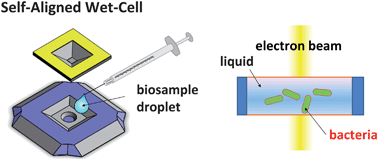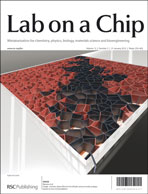Self-aligned wet-cell for hydrated microbiology observation in TEM†
Abstract
This paper describes a Self-Aligned Wet (SAW) cell suitable for direct-cell or bacteria incubation and observation in a wet environment inside a transmission electron microscope. This SAW cell is fabricated by a bulk-micromachining process and composed of two structurally complementary counterparts (an out-frame and an in-frame), where each contain a silicon nitride film based observation window. The in- and out-frames can be self-aligned via a mechanism of surface tension from a bio-sample droplet without the aid of positioning stages. The liquid chamber is enclosed between two


 Please wait while we load your content...
Please wait while we load your content...